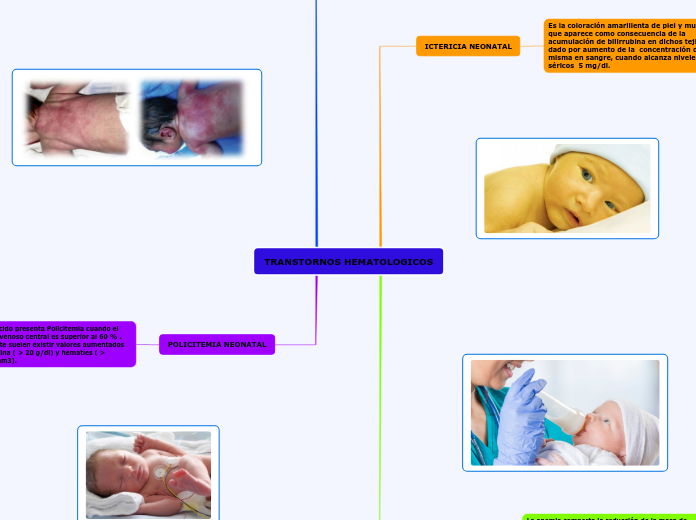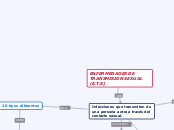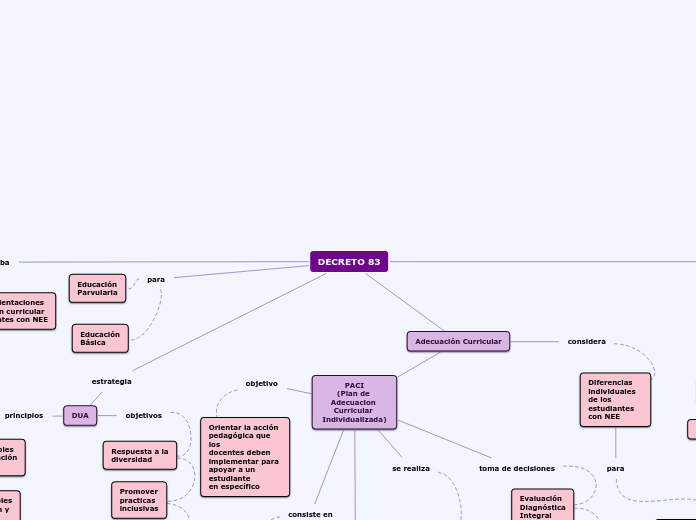TRANSTORNOS HEMATOLOGICOS
In linguistics, syntax is the set of rules, principles, and processes that govern the structure of sentences in a given language, usually including word order.
POLICITEMIA NEONATAL
A complex sentence is a sentence that contains an independent clause and one or more dependent clauses.
An independent clause can stand alone as a sentence, but a dependent clause even though it has a subject and a verb cannot stand alone.
Un recién nacido presenta Policitemia cuando el hematocrito venoso central es superior al 60 % . Habitualmente suelen existir valores aumentados de hemoglobina ( > 20 g/dl) y hematíes ( > 6000000 x mm3).
An appositive clause follows another noun or noun phrase in apposition to it; that is, it provides information that further identifies or defines it.
INTERVENCIONES DE ENFERMERIA:
- Controlara las constantes vitales cada 2 horas y la presión arterial cada 6 hora. Mantener al recién nacido con monitor cardiaco y oxímetro de pulso
- Mantener al recién nacido en un ambiente térmico neutro
- Mantener un acceso venoso permeable
- Balance hídrico estricto con control de la densidad urinaria cada 12 horas
- Monitorizacin de la funcion renal
- Debido al alto riesgo de enterocolitis necrosante
CRITERIOS DE TRATAMIENTO:
Attributive clauses serve as an attribute to a noun (pronoun) in the main clause. This noun or pronoun is called the antecedent of the clause.
Se basan en el valor del hematocrito y la presencia de síntomas.
1) RN con hematocrito mayor a 65 % pero menor a 70 %: sólo se tratarán los sintomáticos y RN con hematocrito mayor a 70 %: se tratarán aunque estén asintomáticos.
A predicative clause may be introduced by conjunctions - that, whether, whether... or, as, as if, as though, because, lest, the way - or connectives.
The latter may be conjunctive pronouns - who, whoever, what, whatever, which - or conjunctive adverbs - where, wherever, when, whenever, how, why.
Cuadro clínico
- Laboratorio determinación del hematocrito, reticulocitosis glucemia bilirruina,electrolitos
- Densidad urinaria
- Rx. de tórax, podría observarse cardiomegalia.
- Rx. abdominal y ecografía abdominal para evaluar signos de enterocolitis necrotizante
Evaluación inicial del recién nacido en quien se sospecha policitemia o presenta factores de riesgo.
- Medir hematocrito venoso. La edad del neonato en el momento de medir es importante. Normalmente el hematocrito aumenta las primeras 2 a 6 horas de vida y se estabiliza a valores reales entre las 8 y 12 horas de vida.
- Realizar un buen examen físico buscando signos y síntomas compatibles con hiperviscosidad.
MANIFESTACIONES CLINICAS:
An adverbial clause is a group of two or more words that function as an adverb in a sentence.
SISTEMA NERVIOSO CENTRAL:
- Letargia
- Pobre alimentacion
- Temblores
- Apnea
- Convulsiones
HETALOGICOS:
- Reticulocitos aumentados
- Trombocitopenia
METABOLICAS:
- Hipoglucemia
- Hipocalcemia
- Hiperbilirrubina
RENAL
- Oliguria
- Proteinuria
- Hematuria
- Trombosis de la vena renal
FACTORES ETIOLOGICOS:
The subject clause is a dependent clause that acts as a subject.
Existe una poliglobulia relativa o hipovolémica secundaria a estados de deshidratación que debe diferenciarse de las poliglobulias absolutas.
De todas estas causas las más frecuentes son las fisiológicas, síndromes transfusionales, hijos de madres diabéticas o toxémicas y los neonatos de bajo peso o con RCIU.
The object clause is a phrase on which a verb performs an action. It falls at the end of a sentence, and is governed by a verb or a preposition.
FACTORES MATERNOS:
- Edad materna avanzada
- Enfermerdades renales, cardiacas o respiratorios
- Diabetes
- Fumar durante el embarazo
FACTORES PLACENTARIOS:
- Alteraciones del cordon umbilical
- Recien nacidos pequeños o grandes para la edad gestacionl
- Hipertension incluida por el embarazo
- Infecciones Virales
FACTORES FETALES:
- Malformaciones cromosomicas
Hipertiroidismo
. Hiperplasia adrenal congenita
- Sindrome de Beckwith
- Asfixia perinatal
- Retardo en la ligadura del cordon umbilical
FACTORES NEONTALES:
- Deshidratacion
Se refiere a los problemas cuantitativos de las plaquetas, es cuando el conteo de plaquetas es inferior a 100 000/mm3
Estos valores son frecuentes en los RN enfermos.
When independent clauses are joined with coordinators (also called coordinating conjunctions), commas and semicolons, they do more than just join the clauses. They add meaning and flow to your writing.
INTERVENCION DE ENFERMERIA:r
- Acciones de enfermería en el RN con trombocitopenia
- Tratar la enfermedad de base.
- Colocar al RN en un ambiente térmico neutro, la hipotermia agrava el cuadro.
- Evitar las extracciones de sangre para exámenes complementarios y las punciones, para
evitar el sangramiento.
- Cardiomonitorizar el paciente, para monitorizar continuamente la frecuencia cardíaca y las saturaciones de oxígeno.
- Vigilar signos y síntomas de complicación.
CLINICA DE LA COAGULOPATIA DE CAUSA PLAQUETARIA:
-Común a todas las TP y a la disfunción plaquetaria Púrpura
- Petequias
- Equimosis
- Sangrado de mucosas (epistaxis, hemorragia digestiva): menos frecuente en neonatos que en niños.
- Prolongación del tiempo de hemorragia(> 3.5 min)
Create your own compound sentences, using the coordinators above.
1. Por eliminación aumentada de plaqueta
- Trombocitopenia autoinmune.
- Trombocitopenia isoinmune.
- Trombocitopenia aloinmune.
- Lupus eritematosos sistémico materno.
- Drogas (aspirina).
- Hiperesplenismo.
- Transfusiones.
2. Por producción disminuida de plaquetas.
- Infiltración de la médula ósea.
- Anemia a plástica.
- Afectación tóxica de los megacariocitos.
- Síndrome de Wiskott Aldrich.
3. Mixtas.
- Infecciones intrauterinas.
- Sepsis.
- Sensibilización a Rh.
- Policitemia.
- Fototerapia.
ANEMIA NEONATAL:
La anemia comporta la reducción de la masa de glóbulos rojos (GR), de la concentración hemoglobina (Hb) o del hematocrito(Ht).
Los valores hematológicos normales varían en función de la edad gestacional y de la edad cronológica.
See the example below and try to create your own simple sentences.
Tim drives.
INDICACIONES DE TRANSFUSION:
See the example below and try to create your own simple sentences.
Tim is driving the red car.
Hematocrito < 20% (Hb < 6) en:
RN asintomático pero reticulocitos <100.000/mm3.
En anemia hemolítica post isoinmunización, aunque asintomático
Hematocrito < 30% (Hb < 9) y:
• FiO2 en cabezal <35%
• FiO2 en cabezal <30% pero <24h vida o <72h vida en <1000 g.
• CPAP o VM con MAP <6 cmH2O.
TRATAMIENTO:
See the example below and try to create your own simple sentences.
Tim is the driver.
1.- Tranfusion concentrado de hematies
RIESGOS DE LA TRANSFUSION SON:
- La sobrecarga de volumen
- La hemolisis
- La hiperpotasemia
- Las infecciones
EFECTOS DE LA TRANSFUSION SON:
- Aumento del hematocrito
- Aumento del transporte de oxigeno
- Aumento de hierro
CAUSAS:
See the example below and try to create your own simple sentences.
Tim is driving the car with his mother.
1.- HEMORRAGICAS: ANTES Y DURANTE EL PARTO
- Hemorragia placenteria
- Hemorragia del cordon umbilical
Hemorragia fetal
. PERIODO NEONATAL:
- Enfermedad hemorragica del recien nacido
- Hemorragia intracraneal
- Cefalohematoma masivo
- Umbilical
- Anemia yatrogeno
2.- HEMOLITICAS:
- Isoinmune
- Autoinmune mterna
- Infecciones
Caencia de Vit. E
3.- HIPOPLASICAS:
- Anemia hipoplasica fisiologica
- Anemia aplasica congenita
- Anemia aplasica scundaria
DIAGNOSTICO:
See the example below and try to create your own simple sentences.
Tim drives the car.
CLINICO:
El signo mas frecuente es la palidez de piel y mucosas (ademas de ictericia en la anemia hemolitica). Segun la etiologia y la velocidad de instauracion se acompañaa de otras manifestaciones:
- En la anemia aguda con gran perdida de volumen aparece clinica de hipovolemica y shock.
- La anemia hemorragica cronica predomina la palidez
ETIOLOGICO:
La anemia tiene su origen en pérdidas sanguíneas, procesos destructivos de los GR o falta de producción.
- Anteparto (hemorragia feto-materna o feto fetal)
- Intraparto (accidentes obstétricos o malformaciones de los vasos de cordón o placenta)
- Posparto (hemorragias internas, exceso de extracciones sanguíneas).
ICTERICIA NEONATAL
Es la coloración amarillenta de piel y mucosas que aparece como consecuencia de la acumulación de bilirrubina en dichos tejidos dado por aumento de la concentración de la misma en sangre, cuando alcanza niveles séricos 5 mg/dl.
Traditional grammar defines the object in a sentence as the entity that is acted upon by the subject.
EXAMENES AUXILIARES:
An adverbial is an individual word (that is, an adverb), a phrase, or a clause that can modify a verb, an adjective, or a complete sentence.
- Grupo sanguíneo y factor Rh en madre y niño.
- Hematocrito, reticulocitos.
- Dosaje de bilirrubinas totales y fraccionadas en sangre periférica.
- Prueba de Coombs: directa e indirecta
- Estudio de lámina periférica (morfología de glóbulos rojos).
- Otros según sospecha clínica
CUADRO CLINICO:
The direct object is the receiver of the action mentioned in the sentence.
1.- La hiperbilirrubinemia indirecta se caracteriza por la pigmentación amarillo claro o anaranjado de piel y mucosas
2.- La hiperbilirrubinemia directa se caracteriza clínicamente por el color amarillo parduzco o verdínico.
3. La encefalopatía por hiperbilirrubinemia, en su fase aguda se acompaña frecuentemente con un cuadro de pobre succión, irritabilidad, fiebre, convulsiones e hipertonía muscular.
The indirect object identifies the person/thing for whom/which the action of the verb is performed.
The indirect object is usually a person or a thing.
FACTORES DE RIESGO:
The predicative is defined as an adjective or noun forming or contained in the predicate.
Its main trait is that it serves to express a property that is assigned to a 'subject'.
For e.g.: The dog is old.
• Prematuridad.
• Bajo peso al nacer.
• Retardo del crecimiento intrauterino (RCIU).
• Colección de sangre extravascular.
• Inadecuado aporte calórico y de volumen.
• Asfixia neonatal.
• Obstrucción intestinal.
• Incompatibilidad sanguínea.
• Infecciones sistémicas.
• Infección urinaria.
CLASIFICACION:
The predicate of a sentence is the part that modifies the subject in some way. Because the subject is the person, place, or thing that a sentence is about, the predicate must contain a verb explaining what the subject does and can also include a modifier.
Ictericia Patológica. (6%)
-Inicio en primeras 24 horas de vida
-Duración mayor de 10 15 días
Bbt > 12 mg/dl RNT y > 14 mg/dl RNPT.
-Hiperbilirrubinemia indirecta ( pigmentación amarillo claro o anaranjado de piel y mucosas.
Ictericia Fisiológica. (60%). Primero hay que demostrar que no es una ictericia patológica
Criterios :
- Aparece Mayor de 24 horas
- Velocidad de ascenso menor de 5 mg/dl/dìa
- Bilirrubina directa de 2 mg. /dl
- La ictericia persistente 2 semanas en RNT, 3 semanas en RNPT.
FISIOPATOLOGIA:
The attribute is defined as a quality or characteristic of a person, place or thing.
- El incremento de bilirrubina sérica se produce por el aumento de la hemólisis, defecto de la conjugación intrahepática, defecto en la excreción ó mixtas.
ETIOLOGIA:
The subject of a sentence is the person, place, thing, or idea that is doing or being something. You can find the subject of a sentence if you can find the verb.
Ask the question, 'Who or what 'verbs' or 'verbed'?' and the answer to that question is the subject.
Ictericia por hiperbilirrubinemia conjugada.
PERIODO NEONATAL:
1.- Ictericia por afectación hepatocelular
2.- Ictericia por afectacion de la via biliar
3.- Otras: Sepsis, infecciones urinarias.
Ictericia por hiperbilirrubinemia indirecta no conjugada
PERIODO NEONATAL:
1.- Ictericia fisiológica: mono sintomática 2 do día, Bb T 12-15 mg/dl 3º5ºdia.
2.- Ictericia por lactancia materna: 4to -7 mo. Día cifras Bb T-20 mg/dl 2da 3ra. Semana
3.- Ictericia patológicas: Ictericia isoinmunes por incompatibilidad Rh ABO, etc.









